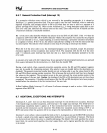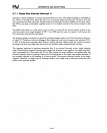
INTERRUPTS
AND
EXCEPTIONS
Table
9-5.
Conditions
That Invalidate the TSS
Reason
Error Code
The
limit in
theTSSdescriptor
is less than 43
TSS id + EXT
Invalid LOT selector
or
LOT not present
LOTid
+ EXT
Stack segment selector is null SS id + EXT
Stack segment selector is outside table limit SS id + EXT
Stack segment is not a writable segment
SS id + EXT
Stack segment OPL does
not
match new CPL SS id + EXT
Stack segment selector RPL;6CPL SS id + EXT
Code segment selector is outside table limit
CS
id + EXT
Code segment selector does not refer
to
code segment CS id + EXT
Non-conforming code segment
OPL;6CPL CS id + EXT
Conforming code segment
OPL>CPL
CS id + EXT
OS
or
ES
segment selector is outside table limits ES/OS id + EXT
OS
or
ES
are not readable segments
ES/OS id + EXT
The error code has the form shown in Table
9-5.
The EXT bit
will
be set if an event external
to
the
program caused an interrupt that subsequently referenced a not-present segment. Bit 1 will
be
set
if
the error code refers
to
an
IDT entry, e.g., an
INT
instruction referencing a not-present gate. The
upper
14
bits are the upper
14
bits of the segment selector involved. .
During a task switch, when a not-present exception occurs, the ES and DS segment registers may not
be usable for referencing memory (the selector values are loaded before the descriptors are checked).
The not-present handler should not rely on being able to use the values found
in
ES, SS, and' DS
without causing another exception. This
is
because the task switch itself may have changed the values
in the registers. The exception occurs in the
new
task and the return pointer points
to
the first
instruc~
tion
oUhe
new
task. Caution: the loading of the DS or ES descriptors may not have been completed.
The exception
II
handler should ensure that the DS and ES descriptors have been properly loaded
before the execution of the first instruction of the
new
task.
9.6.6 Stack Fault (Interrupt 12)
Stack underflow or overflow causes exception
12,
as
does
a not-present stack segment referenced during
an inter-task or inter-level transition. This exception
is
fully restartable. A limit violation of the current
stack results in an error code of
O.
The EXT bit of the error code tells whether an interrupt external to
the;
pfugfiifii cau5ed the
cAccption.
Any instruction that loads a selector to SS (e.g., POP SS, task switch) can cause this exception. This
exception must use a task
gateifthere
is
a possibility that any level 0 stack may not be present.
When a stack fault occurs, the ES and DS segment registers
may not
be
usable for referencing memory.
During a task switch, the selector values are loaded before the descriptors are checked. The stack fault
handler should check
the
saved values
<if
SS, CS, DS, and ES
to
be
sure that they refer
to
present
segments before restoring them.
9-12


















